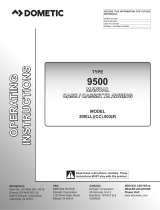Dometic 975XX48, 975XX48, 975XX56, 975XX56, 975XX60, 975XX60 Operating instructions
- Type
- Operating instructions
This manual is also suitable for
Dometic 975XX48, 975XX48, 975XX56, 975XX56, 975XX60, 975XX60 is an automatic RV door awning system designed to provide shelter and protection from the elements. With its sleek design and durable construction, this awning is the perfect addition to any RV.
Dometic 975XX48, 975XX48, 975XX56, 975XX56, 975XX60, 975XX60 is an automatic RV door awning system designed to provide shelter and protection from the elements. With its sleek design and durable construction, this awning is the perfect addition to any RV.















-
 1
1
-
 2
2
-
 3
3
-
 4
4
-
 5
5
-
 6
6
-
 7
7
-
 8
8
-
 9
9
-
 10
10
-
 11
11
-
 12
12
-
 13
13
-
 14
14
-
 15
15
Dometic 975XX48, 975XX48, 975XX56, 975XX56, 975XX60, 975XX60 Operating instructions
- Type
- Operating instructions
- This manual is also suitable for
Dometic 975XX48, 975XX48, 975XX56, 975XX56, 975XX60, 975XX60 is an automatic RV door awning system designed to provide shelter and protection from the elements. With its sleek design and durable construction, this awning is the perfect addition to any RV.
Ask a question and I''ll find the answer in the document
Finding information in a document is now easier with AI
Related papers
-
Dometic 9100 Power Patio Awning Installation guide
-
Dometic 9100 Power Channel Awning Installation guide
-
Dometic Electronic Control Kit 3310287.XXX 3311917.XXX Operating instructions
-
Dometic WeatherPro Power Awning Control System Operating instructions
-
 Oliver Travel Trailers Dometic 9500 User manual
Oliver Travel Trailers Dometic 9500 User manual
-
Dometic Universal Series - Awning; HDWR: 8273000, 8483000, 843000, 8440000; FRTA: Sunchaser, 8500, 9000 Installation guide
-
Dometic Sunchaser 8500 9500 Installation guide
-
Dometic 975 Operating instructions
-
Dometic 9500E 12 VDC Power Case Cassette Awning Installation guide
-
Dometic 9500E 120 Vac Power Case / Cassette Awning Installation guide
Other documents
-
ALEKO RVAW10X8BLK11-HD Installation guide
-
Awnings in a Box 3020814 User manual
-
NuImage Awnings K110909607 User manual
-
Carefree Longitude User manual
-
Carefree OV25APHW Installation guide
-
Carefree Latitude Installation guide
-
Carefree R001642WHT User manual
-
RecPro RP-SAWN-FRM RV Slide Topper Slideout Cover User manual
-
Carefree Travel'r Installation guide
-
Carefree Travel'r User manual















